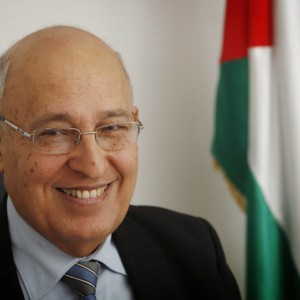Dr. Nabil Shaath: Israel is burying the two-state solution, or Whatever’s left of it

'Strong statements' don’t work. To effectively support the Palestinians and end the occupation, the international community must stop treating Israel as a state above the law.
Nabil Sha'athAug 31, 2016 12:27 PM
When the Israeli occupying forces uprooted olive trees in the Cremisan Valley/Bir Onah area in the northern Bethlehem District a year ago, to make way for the development of a new illegal settlement, we Palestinians did not mince words about the Israeli government’s dangerous path towards hammering the last nail in the coffin of the two-state solution.
It was clear that the goal of the wall was to secure a de facto annexation of Palestinian land in order to link the illegal Israeli settlements of Gilo and Har Gilo, built on opposite sides of the Cremisan Valley.
Though there was a significant international campaign to stop Israel’s wall in the area, the Israeli government moved ahead, knowing full well that they would not be held accountable for their ongoing and systematic violations of international law.
In 1968, Israel established the illegal settlement of Har Gilo on the hills of Beit Jala, the highest point in the Bethlehem District. It expanded over the Walajeh village-owned lands and now hosts approximately 2,000 illegal settlers, overlooking Jerusalem and the eastern Bethlehem villages.
Only a few weeks ago, the Israeli housing minister announced the government’s intention to further expand several settlements in the same area, between Bethlehem and Hebron, in order to reach to half a million settlers within the next few years.
In 1971, Israel established the settlement of Gilo, also on Beit Jala’s land. The site, known as Al Slayeb, was the natural area of expansion for this ancient Palestinian Christian town, and used to host one of the vital quarries in Palestine, as well as agricultural terraces.
Currently, there are over 30,000 settlers in Gilo living in over 9,000 housing units, with another 7,300 units in various phases of construction according to the Israeli master plan for the area.
To Israel, the 1967 border simply doesn’t exist anymore. The Cremisan area is a good example of such a policy. While the Har Gilo settlement has reached unprecedented expansion since Israel’s Annexation Wall began to be built in the area.
It is not a mere coincidence that right after Israel began to build the wall in Cremisan, several settlement construction announcements were made, including almost 3,400 units in the Gilo settlement. Construction for another 700 units, approved in 2014, also began last year.
In parallel, other settlement infrastructure in the works include a highway to link the illegal settlements of the Hebron and Bethlehem areas with the road to Tel Aviv, which has severely disrupted the people of Beit Safafa.
There has also been Palestinian land confiscated from the Walajeh and Beit Jala areas, and declared as “national parks” by Israel, in an underhanded attempt to annex more land and strengthen contiguity between illegal settlements and bolster the settlement roadway system from the north to the western and southern regions.
In 2004, the International Court of Justice at The Hague declared the Israeli annexation wall in occupied Palestine illegal under international law, and stated that it must be dismantled.
The international community has a responsibility to fulfill the inalienable right of the Palestinian people to self-determination, which is systematically and directly obstructed by the wall.
In the case of Cremisan we can see how a combination of strong statements from the United States, United Kingdom, Germany, European Union, United Nations, Holy See, World Council of Churches and several other countries and international actors have yet to prevent Israel from moving ahead with its illegal plans.
Just a few weeks ago, approximately 20 people were displaced from Cremisan after Israel demolished their homes. The same day 12 Palestinian structures and homes had been demolished elsewhere in occupied Palestine.
These “strong statements” from the international community are not going to stop the suffering of those people, nor will humanitarian aid, including tents, compensate for the loss of their homes.
These demolitions are part of a larger policy to annex occupied territory to Israel. Only when the international community stops treating Israel as a state above the law will they effectively support the people of Palestine and end the decades-long occupation.
We must continue accessing every possible avenue, including the UN Security Council, international organizations, international civil society campaigns, the International Criminal Court, and even local courts.
Cremisan proves that “strong statements” with no action are nothing but an invitation to continue the systematic violations of the inalienable rights of the Palestinian people, thereby burying the two-state solution – or whatever is left of it.
Dr. Nabil Sha'ath is the Fatah International Relations Commissioner and former Palestinian foreign minister (1994-2005).